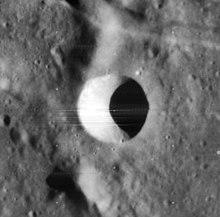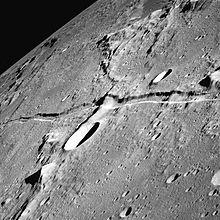 Lunar Orbiter 4 image | |
| Coordinates | 6°12′N 12°30′E / 6.2°N 12.5°E |
|---|---|
| Diameter | 13 km |
| Depth | 2.5 km |
| Colongitude | 348° at sunrise |
| Eponym | Johann Silberschlag |

Silberschlag (below and left of center) and Rima Ariadaeus from Apollo 10. NASA photo.
Silberschlag is a small, circular Impact crater in the central portion of the Moon. It was named after German astronomer Johann Silberschlag.[1] It lies between the craters Agrippa to the southwest and Julius Caesar to the northeast. Silberschlag is bowl-shaped and is joined at the northern rim by a small ridge.
Just to the north is the prominent Rima Ariadaeus, a wide, linear rille that runs toward the east-southeast. This cleft is about 220 kilometers in length, and continues to the edge of Mare Tranquillitatis to the east.
Satellite craters
By convention these features are identified on lunar maps by placing the letter on the side of the crater midpoint that is closest to Silberschlag.
| Silberschlag | Latitude | Longitude | Diameter |
|---|---|---|---|
| A | 6.9° N | 13.2° E | 7 km |
| D | 7.5° N | 11.2° E | 4 km |
| E | 5.2° N | 12.8° E | 4 km |
| G | 5.7° N | 13.8° E | 3 km |
| P | 6.7° N | 12.0° E | 25 km |
| S | 8.0° N | 12.1° E | 34 km |
References
- ^ "Silberschlag (crater)". Gazetteer of Planetary Nomenclature. USGS Astrogeology Research Program.
- Andersson, L. E.; Whitaker, E. A. (1982). NASA Catalogue of Lunar Nomenclature. NASA RP-1097.
- Bussey, B.; Spudis, P. (2004). The Clementine Atlas of the Moon. New York: Cambridge University Press. ISBN 978-0-521-81528-4.
- Cocks, Elijah E.; Cocks, Josiah C. (1995). Who's Who on the Moon: A Biographical Dictionary of Lunar Nomenclature. Tudor Publishers. ISBN 978-0-936389-27-1.
- McDowell, Jonathan (July 15, 2007). "Lunar Nomenclature". Jonathan's Space Report. Retrieved 2007-10-24.
- Menzel, D. H.; Minnaert, M.; Levin, B.; Dollfus, A.; Bell, B. (1971). "Report on Lunar Nomenclature by the Working Group of Commission 17 of the IAU". Space Science Reviews. 12 (2): 136–186. Bibcode:1971SSRv...12..136M. doi:10.1007/BF00171763.
- Moore, Patrick (2001). On the Moon. Sterling Publishing Co. ISBN 978-0-304-35469-6.
- Price, Fred W. (1988). The Moon Observer's Handbook. Cambridge University Press. ISBN 978-0-521-33500-3.
- Rükl, Antonín (1990). Atlas of the Moon. Kalmbach Books. ISBN 978-0-913135-17-4.
- Webb, Rev. T. W. (1962). Celestial Objects for Common Telescopes (6th revised ed.). Dover. ISBN 978-0-486-20917-3.
- Whitaker, Ewen A. (1999). Mapping and Naming the Moon. Cambridge University Press. ISBN 978-0-521-62248-6.
- Wlasuk, Peter T. (2000). Observing the Moon. Springer. ISBN 978-1-85233-193-1.